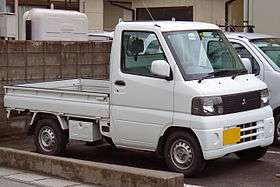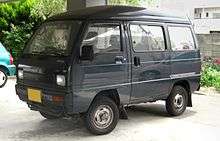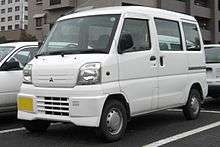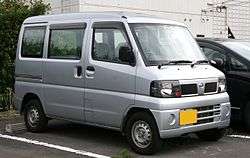Mitsubishi Minicab
| Mitsubishi Minicab | |
|---|---|
 | |
| Overview | |
| Manufacturer |
|
| Also called |
Mitsubishi Veryca (Taiwan) Mitsubishi Jetstar (Indonesia) Mitsubishi L100 Nissan Clipper Nissan NT100 Clipper (2012-2013) Nissan NV100 Clipper (2012-2013) CMC Varica |
| Production | 1966–present |
| Assembly | Mizushima plant, Kurashiki, Okayama, Japan |
| Body and chassis | |
| Class |
Microvan Kei truck |
| Body style |
Van Pickup truck |
| Layout | FR layout, F4 layout |
| Powertrain | |
| Engine |
359 cc ME24 I2 two-stroke 359 cc 2G10 I2 two-stroke 471 cc 2G22 I2 546 cc 2G22 I2 644 cc 2G24 I2 783 cc 2G25 I2 796 cc 3G82 I3 659 cc 4A30 I4 1.1 L 4G82 I4 |
| Chronology | |
| Predecessor | Mitsubishi 360 |
The Mitsubishi Minicab is a cabover kei truck and microvan built and sold in Japan by the Japanese automaker Mitsubishi Motors since 1966. In Japan, it was sold at a specific retail chain called Galant Shop. An all-electric model of the Minicab, called the Minicab MiEV, is sold in the Japanese market since December 2011.[1] It was also sold by China Motor Corporation (CMC) in Taiwan as the CMC Verica, starting in 1985.
First generation
The Minicab cab-over pickup truck was launched in 1966 to replace the 360 trucklet, which by this time had adopted the same model name as the Minica sedan. Codenamed LT30 it shared the sedan's air cooled two-stroke 359 cc ME24 engine, and was available with cargo gates on three sides to simplify loading and unloading. A van version was introduced in 1968, available in four different equipment levels.[2] The T30 truck was replaced in 1971 by the new Minicab EL, but the van was kept in production (now also called the "Minicab EL") and updated with a dummy grille and headlight surround. The air-cooled T30V with its 26 PS (19 kW) engine was kept in production until 1976, with no further modifications except a 1974 adjustment to fit larger license plates. The better equipped Super Deluxe version received a version of the ME24 engine with 30 PS (22 kW).[3] 224,766 first generation Minicabs were built.[4]
Second generation
In 1971 the Minicab underwent its first model change, with the Minicab EL offering a new interior and a longer cargo bed. Called the T130 it was only available in truck form, with the old LT30 van soldiering on until the third generation was introduced in 1976. Ride quality was improved with the adoption of a front wishbone and rear leaf spring suspension. The EL received all new bodywork with tiny rectangular headlamps.
A panel van was added to the Minicab truck lineup in 1972, when it also became the Minicab W with the new water-cooled 2G10 engine (hence the W).[2] This model carries the T131 chassis code and is easily identified by its reworked front end, reverting to round headlights. It also carries a prominent "W" on the front, beneath the left headlight. The grille was altered and the headlights made larger yet in 1973, with the "W" replaced by a "Minicab" script. For 1975 the Minicab received an emissions cleaned engine using Mitsubishi MCA technology, still with 28 PS (21 kW). 209,774 second generation Minicabs were built, making it the slowest selling generation.[4] The third generation, however, was mostly a heavily modified T130.
Third generation
In April 1976, the third generation Minicab was introduced. In keeping with the changes in vehicle tax regulations, the Minicab 5 (L012) featured an increase in length, and adopted the enlarged 471 cc Vulcan S engine from the car line, still with the same max power as the 360. It also incorporated new features like a windscreen defroster, a central console box and a central ventilation system. This engine did not take full advantage of the new regulations, which allowed up to 550 cc, and was only used in a short-lived group of interim models.
It was modified again in April 1977, when it was widened and received a full 546 cc engine and the new name "Minicab Wide 55" (L013). Power was increased marginally to 29 PS (21 kW). It continued until 1979, when Mitsubishi dropped "Wide 55" from the Minicab name as the market was now considered to be aware of the increase in body size and engine capacity. Power also increased by two horsepower at this time. For some export markets, such as Chile, this version was known as Mitsubishi L100.[2] This model was thoroughly updated in 1981, when the engine was changed to the timing belt-equipped 2G23. At the same time, the name was changed back t simply "Minicab", and the chassis code was switched to L015. In 1982 the flat-floor Van model adopted a double-walled construction to offer a flat, open cargo area. The 4WD model was also introduced in 1982, when the range received a minor facelift. Overall, 768,393 third generation Minicabs (L012, L013, L015) were built.[4]
In China the third generation was built and sold as both the Shenwei SYW 1010 and as the Liuzhou Wuling LZ 110.[5] The LZ 110 was available as a van or as a truck, and had Mitsubishi's larger 800 cc engine as fitted to certain other Mitsubishi export versions.
Fourth generation
| Fourth generation (U11/12/14/15/18/19) | |
|---|---|
 Minicab Super Deluxe truck (U11T) | |
| Overview | |
| Manufacturer | Mitsubishi Motors |
| Also called |
|
| Production |
1984.06–1991.01 1990–2009 (China) |
| Assembly | Mizushima plant, Kurashiki, Okayama, Japan |
| Body and chassis | |
| Body style | Pickup truck, microvan |
| Layout | FR layout, F4 layout |
| Related | Cushman White Truck[6] |
| Powertrain | |
| Engine | |
| Dimensions | |
| Wheelbase | 1,780 mm (70.1 in) |
| Length |
|
| Width | 1,395 mm (54.9 in) |
Further model range updates have been in parallel with the Minica. In June 1984 the range was updated, becoming the fourth generation U11/12 series (2WD/4WD).[7] Although improvements were made to enhance the Minicab's commercial applications, the most noticeable changes were made to support personal leisure activities. Angular headlamps played an important role in the Minicab's styling, along with larger windows to improve visibility. A rear window wiper, electronic locking rear gate and power brakes were adopted. Mitsubishi offered fifteen front- and four-wheel drive van model variations and ten truck variations. This was also when the "Bravo" name was added to better equipped van models. This generation (collectively referred to as the U10)[4] was built until November 1990, eventually reaching the U19 chassis code. In total, 707,348 fourth generation Minicabs were built.[4]

Additional models went on sale in February 1985, and it received a small facelift in September of that year. In February 1986 the van range received two additions: a 2WD automatic and a dual-range, five-speed 4WD model.[7] In June 1987, a more thorough change took place as the two-cylinder Vulcan-II engine was replaced with the three-cylinder Cyclone (3G81). A supercharged model was added to the lineup, which was now called U14/U15. In August 1988 there was a facelift, and in April 1989 the NX and Bravo AX models were added (both with four-wheel drive).[7] In January 1990, naturally aspirated models were upgraded to the 657 cc 3G83 engine (U18/U19), as a result of new regulations, while a minor facelift with bigger front and rear bumpers increased the length marginally. Vans were now 3,265 mm (128.5 in) long, while trucks were 3,225 mm (127.0 in).[8] The car did not take full advantage of the new rules, as it was a rather short-lived interim model, and supercharged versions continued to use the smaller engine until they were discontinued in 1990. Those received a "G" at the end of the chassis codes, meaning that a four-wheel-drive supercharged van would now be the U15VG and so on.[7]
The fourth generation Minicab incorporated many class-leading features such as an automatic free-wheel hub adopted on all four-wheel drive models, while two-wheel drive models had a turning radius of 3.7 metres (12.1 ft). The estate models featured the first sliding sunroof in their class. In 1987, the Minicab became the first manufacturer to offer a supercharged kei truck.[2] It was also marketed in the United States for off-road purposes only, where it was sold as the "Mighty Mits."
Production elsewhere
In China the fourth generation Minicab was built and sold as the Wuling LZW 1010 for the commercial variants and the Wuling LZW 6330 for the passenger variant from 1990 to 2009.[5] From 1986 until 1989 a wider version with a longer rear end was built and sold in Indonesia as the "Jetstar".[9] This model corresponds to the Verica built by CMC in Taiwan, excepting the one-liter 53 PS (39 kW) Daihatsu-built CB20 engine, which was installed to meet local parts requirements although Mitsubishi's local affiliate did not build a suitable engine. The Jetstar was available as a minibus (Diplomat or fully equipped Royal) or as a pickup truck, and has a waffle-patterned faux grille up front.
CMC Verica
In Taiwan, as in mainland China, long wheelbase iterations of the fourth generation Minicab were also available with a variety of bodywork. The Taiwanese version (built by CMC, China Motor Corporation) was called the CMC Verica (中華威利, Zhōnghuá Wēi Lì) and was available with a 1061 cc 4G82 engine with 58 PS (43 kW). Overall length was up to 3,645 mm (143.5 in), with a wheelbase lengthened to 1,475 mm (58.1 in) right in front of the rear axle. Top speed was 115 km/h (71 mph).[10] The Varica's nose was also extended somewhat.
Later a 1.2-litre version replaced the smaller 1100, and the car underwent a facelift which included a longer more rounded nose. From November 2004 India's Premier has been building a diesel powered version of the Verica.[11] Its body panels are shipped from Taiwan, and a Hindustan-built 2-liter Isuzu diesel unit is fitted. It has 58 hp (43 kW) and is mated to a four-speed manual gearbox, while the car offers from five to nine seats.[12] A multitude of other versions have since been developed, and as of 2009 the engine has been replaced by a 1.5 liter IDI diesel (with or without turbo) or by the CNG-powered 1.8-liter 4ZB1 (both still manufactured by Hindustan).[13] The Sigma was discontinued around 2012, but the pickup version (called the Premier Roadstar) remains available as of 2013.
In 2013, CMC launched its first independent product, the CMC Leadca, redesigned all of its products, and started to brand them with the CMC badge instead of the Mitsubishi badge. The Delica and Verica received their CMC facelift in 2013 while the CMC Zinger was not facelifted until 2015.
 First generation CMC Verica 1100DX van
First generation CMC Verica 1100DX van Second generation CMC Verica 1100DX truck
Second generation CMC Verica 1100DX truck Third generation CMC Verica 1200 van
Third generation CMC Verica 1200 van Fourth generation CMC Veryca van pre-facelift front view
Fourth generation CMC Veryca van pre-facelift front view Fourth generation CMC Veryca van pre-facelift rear view
Fourth generation CMC Veryca van pre-facelift rear view Fourth generation CMC Veryca facelift van front view
Fourth generation CMC Veryca facelift van front view- Fourth generation CMC Veryca facelift van rear view
Fifth generation
A larger and completely redesigned Minicab (U40-series) was released in 1991 to take advantage of tax regulations allowing for increased dimensions and engine capacity of kei cars. Three new 660cc engines were introduced: a 4-valve SOHC unit, a 5-valve DOHC unit and a 2-valve SOHC unit. Across the range, there was a total of 66 possible model variations.[2] This included a new variant, the retro-styled Bravo Route 66, however, one previous variant, the high-roof truck, was discontinued.[5] 723,772 fifth generation Minicabs were built.[4] The Minicab also wore the Chrysler L100 nameplate.
Sixth generation

The sixth generation Minicab (U60-series) was introduced in 1999 now sporting a new semi-front design. By April 1999, a "wagon" version called the Town Box was introduced. 419,070 petrol-engined U60s were built,[4] but the Minicab MiEV remains in production as of 2017.
Minicab MiEV
_demo-car.jpg)
Mitsubishi began testing of the Minicab MiEV in Japan in October 2010.[1] In January 2011, Mitsubishi announced that it would add an electric version of Minicab, Minicab MiEV, for sale in Japan in the third quarter of 2011. Mitsubishi later announced a December 2011 launch.[14]
Mitsubishi picked up early orders for 100 units from major delivery company Yamato Transport in May of that year.[15] The commercial use electric vehicle is estimated to have a range of 100 km (62 mi) with a full charge, which is lower than that of i-MiEV, in a bid to reduce costs. The price is aimed for less than ¥2,000,000 (about US$24,450) after subsidies.[16]
The Minicab MiEV was released in the domestic market in December 2011,[1][17] and a total of 4,544 units have been sold in Japan through October 2013.[18] A truck version of the Minicab MiEV was launched in January 2013,[19] and sales totaled 536 units through October 2013.[18]
Nissan Clipper
Mitsubishi also manufactured a badge-engineered version of the Minicab pickup on behalf of Nissan, which sells it as the Nissan Clipper (a badge originally used on a larger range of Prince and Nissan trucks).[20] The Minicab/Clipper competes in Japan with the Honda Acty, Subaru Sambar, Daihatsu Hijet, and the Suzuki Carry.
Gallery
 Interior (Early)
Interior (Early) Interior (Later: Minicab MiEV)
Interior (Later: Minicab MiEV) Mitsubishi Minicab MiEV (Van)
Mitsubishi Minicab MiEV (Van).jpg) Mitsubishi Minicab MiEV (Truck: Prototype)
Mitsubishi Minicab MiEV (Truck: Prototype) Nissan Clipper
Nissan Clipper
Seventh generation
The seventh generation Mitsubishi Minicab is a rebadged Suzuki Carry and Every. It was introduced in February 2014.
Eighth generation
The eighth generation Mitsubishi Minicab was introduced in March 2015, and is also a rebadged Suzuki Every.
References
- 1 2 3 "Mitsubishi Motors starts taking orders for Minicab-MiEV commercial mini EV". Mitsubishi Motors Australia. Archived from the original on 3 December 2013. Retrieved 27 June 2011.
- 1 2 3 4 5 "Minicab". Mitsubishi Motors History. Mitsubishi-Motors.co.za. Archived from the original on 26 June 2008.
- ↑ "自動車ガイドブック: Japanese motor vehicles guide book 1972—73" (in Japanese). 19. Japan: Japan Automobile Manufacturers Association. 23 October 1972: 178.
- 1 2 3 4 5 6 7 "40th Anniversary minicab" (in Japanese). Tokyo, Japan: Mitsubishi Motors. Retrieved 19 July 2017.
- 1 2 3 Schaefers, Martin. "History of Japanese Kei Class Minivans and Trucks". Far East Auto Literature. Retrieved 20 April 2011.
- ↑ "Cushman White Truck Parts". Mini Truck Parts. Retrieved 11 June 2018.
- 1 2 3 4 主要部品カタログ MINICAB [Main Parts Catalog: Minicab] (Parts Catalog) (in Japanese), Tokyo, Japan: Mitsubishi Motors, September 1991, p. A4, A0248800K2
- ↑ 自動車ガイドブック [Japanese Motor Vehicles Guide Book 1990~'91] (in Japanese), 37, Japan: Japan Automobile Manufacturers Association, 25 October 1990, pp. 257, 274, 0053-900037-3400
- ↑ Fourie, Louis F. (29 December 2016). On a Global Mission: The Automobiles of General Motors International. 3. Friesen Press. p. 1239.
- ↑ Mitsubishi Verica New Tone 1100 (catalog). Old Car Manual Project. 1991. Retrieved 12 October 2010.
- ↑ Mazur, Eligiusz, ed. (2006). World of Cars 2006·2007. Warsaw, Poland: Media Connection Sp. z o.o. p. 153. ISSN 1734-2945.
- ↑ Krishnan, Srinivas (20 November 2004). "Premier Sigma - Van Diesel". Business Standard Motoring. Retrieved 21 September 2013.
- ↑ Premier Sigma: India's first compact diesel van (brochure), Pune, India: Premier Ltd., 2010
- ↑ Lienert, Paul. "Mitsubishi To Unveil Plug-In Hybrid Concept: 2011 Tokyo Auto Show". Edmunds Inside Line. Retrieved 14 November 2011.
- ↑ Stephen Munday (26 May 2011). "Yamato Takyubin Delivery Co. Orders 100 Minicab-MiEV Vans". Integrity Exports.
- ↑ Isabel Reynolds (21 January 2011). "Mitsubishi Motors to use Toshiba battery in EV: report". Reuters.
- ↑ Eric Loveday (11 December 2011). "Mitsubishi to Launch Electric Mini Truck in 2012". PluginCars.com. Retrieved 5 October 2012.
- 1 2 "三菱 i-MiEVなどの2013年10月度 販売実績" [Mitsubishi i-MiEV sales results for October 2013] (in Japanese). Electric Vehicle News. 28 November 2013. Retrieved 30 November 2013.
- ↑ Mark Kane (10 June 2013). "Mitsubishi's Pure Electric Vehicle Sales Tumbling in Japan as Outlander PHEV Dominates". InsideEVs.com. Retrieved 16 June 2013.
- ↑ "Mitsubishi supplies Nissan with mini-vehicles". AM Online. 10 August 2006. Retrieved 4 September 2011.
External links
| Wikimedia Commons has media related to Mitsubishi Minicab. |
- Mitsubishi Minicab official site (Japanese)
- Mitsubishi Minicab history, Mitsubishi Motors South Africa website
Mitsubishi Motors automobile timeline, 1960–1979 — next » | |||||||||||||||||||||||||||||||||||||||||||||||||
|---|---|---|---|---|---|---|---|---|---|---|---|---|---|---|---|---|---|---|---|---|---|---|---|---|---|---|---|---|---|---|---|---|---|---|---|---|---|---|---|---|---|---|---|---|---|---|---|---|---|
| Type | 1960s | 1970s | |||||||||||||||||||||||||||||||||||||||||||||||
| 0 | 1 | 2 | 3 | 4 | 5 | 6 | 7 | 8 | 9 | 0 | 1 | 2 | 3 | 4 | 5 | 6 | 7 | 8 | 9 | ||||||||||||||||||||||||||||||
| Kei sedan | Minica | Minica 70-73 | Minica F4 | Minica 5 | Minica Ami 55 | ||||||||||||||||||||||||||||||||||||||||||||
| Minica Skipper | |||||||||||||||||||||||||||||||||||||||||||||||||
| Kei truck/Microvan | 360 Van/Pickup | Minica Van | Minica 5 Van | Minica 55 Van | |||||||||||||||||||||||||||||||||||||||||||||
| Minicab | Minicab EL | Minicab W | Minicab 5 | Minicab Wide 55 | |||||||||||||||||||||||||||||||||||||||||||||
| Subcompact | 500 | Colt 600 | Colt 800 | ||||||||||||||||||||||||||||||||||||||||||||||
| Colt 1000F | Colt 1100F/11-F | ||||||||||||||||||||||||||||||||||||||||||||||||
| Mirage | |||||||||||||||||||||||||||||||||||||||||||||||||
| Compact | Colt 1000 | Colt 1100 | Colt 1200 | Lancer | Lancer EX | ||||||||||||||||||||||||||||||||||||||||||||
| Colt 1500 | (Colt) Galant | Galant | Galant Σ | ||||||||||||||||||||||||||||||||||||||||||||||
| Sports coupé | Galant FTO | Lancer Celeste | |||||||||||||||||||||||||||||||||||||||||||||||
| Galant GTO | Galant Λ | ||||||||||||||||||||||||||||||||||||||||||||||||
| Executive | Debonair | ||||||||||||||||||||||||||||||||||||||||||||||||
| Van | Delica T100 | Delica T120/75 | Delica T120/1400 | Delica | |||||||||||||||||||||||||||||||||||||||||||||
| Pickup truck | Forte | ||||||||||||||||||||||||||||||||||||||||||||||||